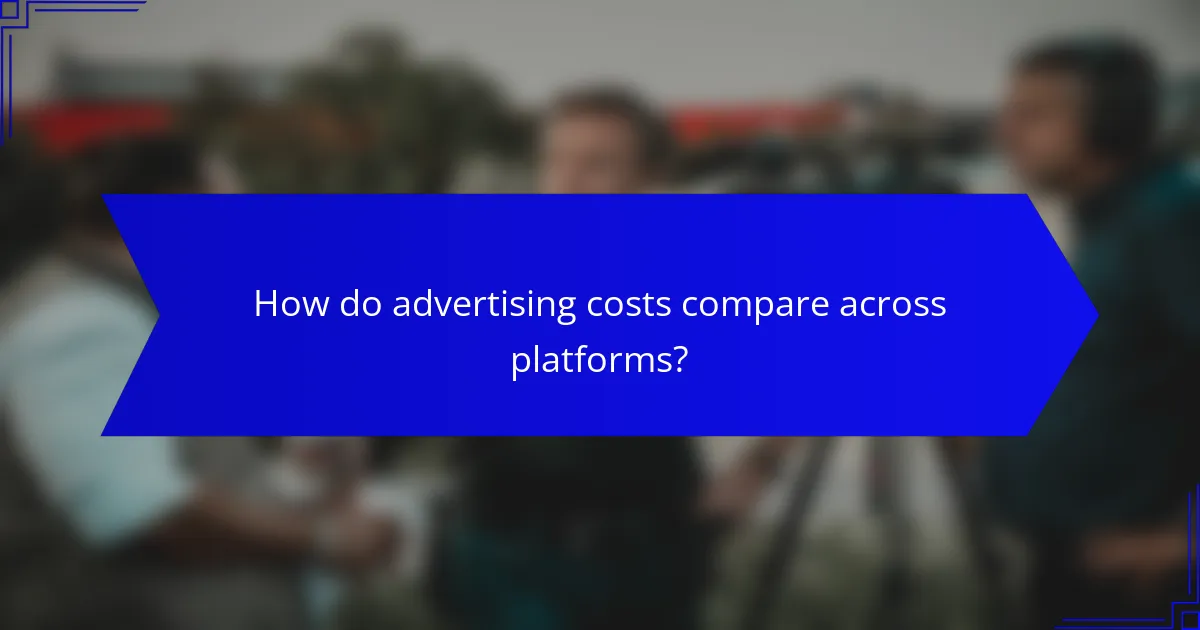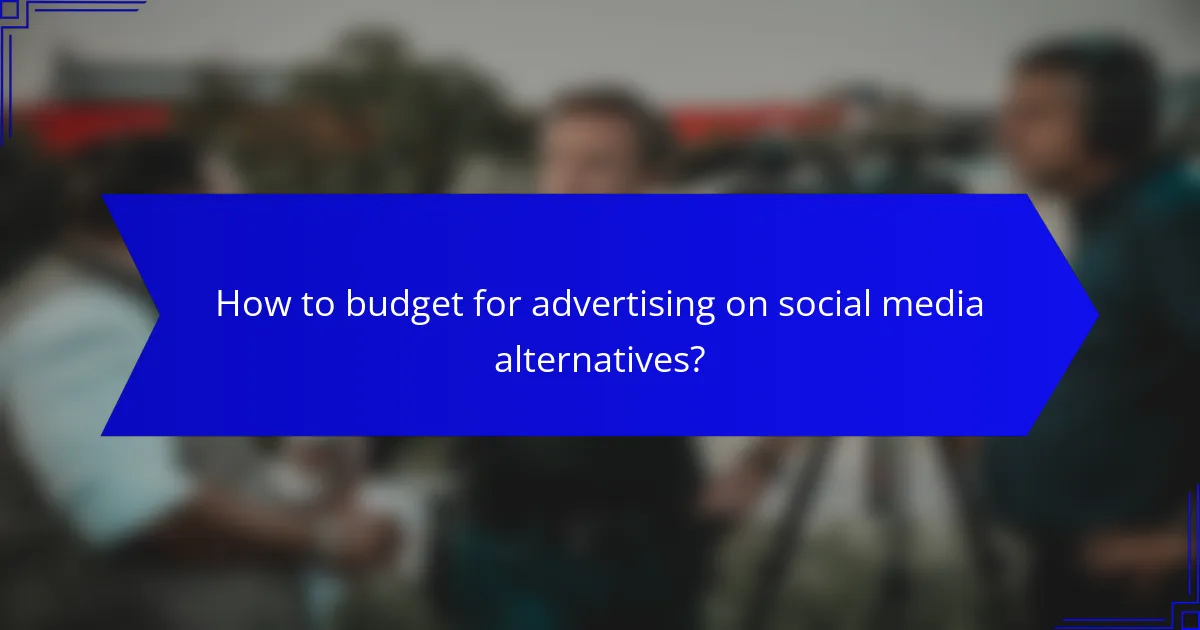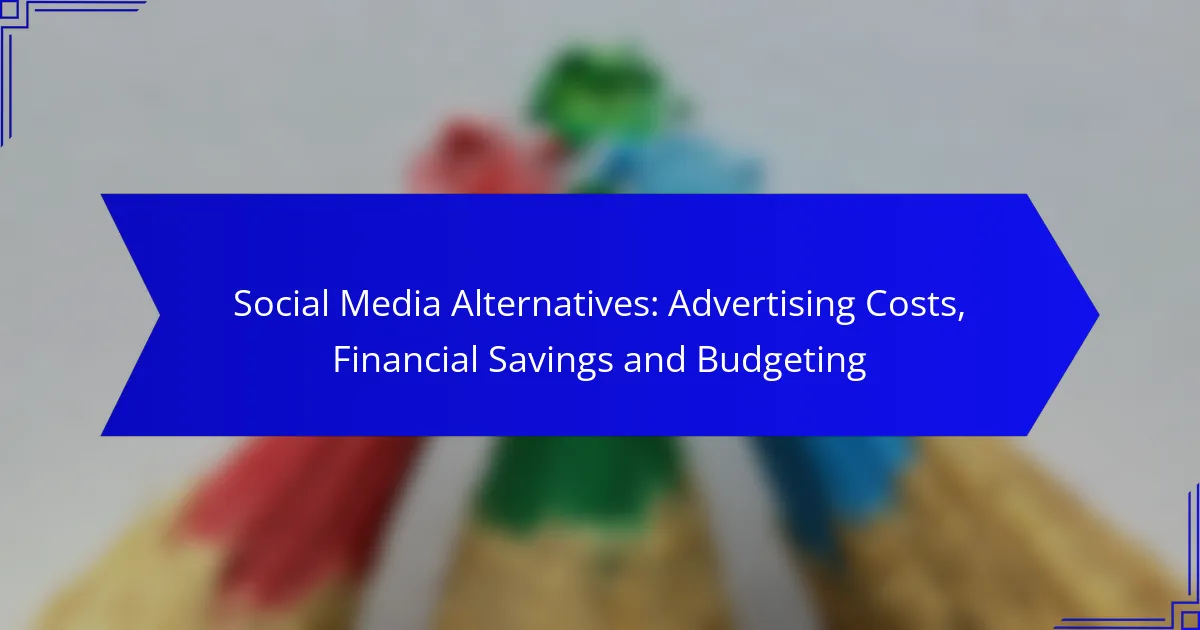As businesses seek effective ways to reach their target audiences, exploring social media alternatives for advertising can be a game-changer. Platforms like LinkedIn, Reddit, Pinterest, Snapchat, and Twitter not only cater to diverse demographics but also offer varying advertising costs that can lead to significant financial savings. By understanding these costs and optimizing their budgets, companies can enhance their marketing strategies and achieve better returns on investment.

What are the best social media alternatives for advertising?
Some of the best social media alternatives for advertising include LinkedIn, Reddit, Pinterest, Snapchat, and Twitter. Each platform offers unique features and audience demographics, making them suitable for different advertising goals and budgets.
LinkedIn Ads
LinkedIn Ads are ideal for B2B marketing, targeting professionals and decision-makers. Advertisers can choose from various ad formats, including sponsored content, message ads, and dynamic ads, allowing for tailored messaging.
Costs for LinkedIn Ads can vary widely, typically ranging from $2 to $7 per click or $6 to $9 per 1,000 impressions. It’s essential to define your target audience clearly to maximize your return on investment.
Reddit Ads
Reddit Ads allow businesses to engage with niche communities through sponsored posts and display ads. The platform’s unique structure means ads can be highly targeted based on subreddit interests.
Advertising costs on Reddit generally start at around $0.75 per click, with options for cost-per-impression campaigns as well. Understanding the culture of specific subreddits is crucial for effective ad placement and engagement.
Pinterest Ads
Pinterest Ads are particularly effective for brands in lifestyle, fashion, and home improvement sectors, as users often seek inspiration. Promoted Pins blend seamlessly into users’ feeds, increasing visibility.
Costs typically range from $0.10 to $1.50 per click, depending on competition and targeting options. Utilizing high-quality visuals and clear calls to action can significantly enhance ad performance.
Snapchat Ads
Snapchat Ads cater to a younger audience, making them suitable for brands targeting Gen Z and millennials. The platform offers various ad formats, including Snap Ads, Story Ads, and AR lenses.
Advertising on Snapchat can cost between $0.10 and $0.30 per swipe, with a minimum spend requirement. Creative, engaging content that resonates with the audience is vital for success on this platform.
Twitter Ads
Twitter Ads provide a platform for real-time engagement and conversation. Advertisers can promote tweets, accounts, or trends, making it suitable for both brand awareness and direct response campaigns.
Costs for Twitter Ads usually range from $0.50 to $2.00 per engagement. Crafting concise, impactful messages is essential, as Twitter’s character limit can challenge advertisers to communicate effectively.

How do advertising costs compare across platforms?
Advertising costs vary significantly across social media platforms, influenced by factors such as audience targeting, ad format, and competition. Understanding these costs can help businesses allocate their budgets more effectively and maximize their return on investment.
Cost per click on LinkedIn
LinkedIn typically has higher cost per click (CPC) rates compared to other platforms, often ranging from $5 to $10. This premium reflects its professional audience and effective targeting capabilities, making it suitable for B2B marketing.
When budgeting for LinkedIn ads, consider the industry and competition. Industries like technology and finance may see higher CPCs due to increased demand for visibility among professionals.
Cost per impression on Reddit
On Reddit, the cost per impression (CPM) can range from $0.75 to $3, depending on the subreddit and audience targeting. This platform offers a unique opportunity to reach niche communities, which can enhance ad effectiveness.
To optimize costs, focus on specific subreddits that align with your target audience. Engaging with the community through organic posts can also improve ad performance and reduce costs.
Cost per engagement on Pinterest
Pinterest advertising typically charges around $2 to $5 per engagement, which includes actions like saves and clicks. This platform is ideal for visually-driven brands, particularly in fashion, home decor, and food sectors.
To maximize engagement, create visually appealing pins and use keywords that resonate with your target audience. Testing different formats can help identify what drives the best results.
Cost per view on Snapchat
Snapchat’s cost per view (CPV) generally falls between $0.10 and $0.30. This platform is popular among younger demographics, making it effective for brands targeting millennials and Gen Z.
When using Snapchat ads, consider using video formats to capture attention quickly. Engaging content that encourages interaction can lead to lower CPV and higher overall engagement.
Cost per tweet engagement on Twitter
On Twitter, the cost per engagement (CPE) can range from $0.50 to $3, depending on the ad type and targeting options. This platform is effective for real-time engagement and reaching audiences during trending events.
To enhance CPE, utilize eye-catching visuals and concise messaging. Monitoring trending topics and participating in conversations can also improve engagement rates and reduce costs.

What financial savings can be achieved with social media alternatives?
Social media alternatives can lead to significant financial savings by offering lower advertising costs compared to traditional platforms. By exploring options like Reddit, Pinterest, and Snapchat, businesses can optimize their marketing budgets and achieve better returns on investment.
Lower CPC on Reddit
Reddit typically offers a lower cost per click (CPC) compared to mainstream social media platforms. Advertisers can expect CPCs in the low single-digit USD range, making it an attractive option for budget-conscious marketers.
Targeting specific subreddits allows advertisers to reach niche audiences effectively, which can enhance engagement and conversion rates. However, it’s essential to craft ads that resonate with Reddit’s unique community culture to avoid backlash.
Budget-friendly options on Pinterest
Pinterest provides budget-friendly advertising options with a CPC that can be lower than that of Facebook or Instagram. Advertisers can often achieve CPCs in the mid-single-digit USD range, depending on the campaign’s targeting and objectives.
Utilizing visually appealing pins and optimizing for keywords can lead to higher visibility and engagement. Businesses should focus on seasonal trends and popular categories to maximize their advertising impact on Pinterest.
Cost-effective campaigns on Snapchat
Snapchat offers cost-effective advertising solutions, particularly for brands targeting younger demographics. With CPCs often in the low to mid-single-digit USD range, it presents a viable option for businesses looking to engage with Gen Z and millennials.
Snapchat’s unique ad formats, such as Stories and AR lenses, can enhance user interaction. Advertisers should consider using creative and engaging content to capture attention and drive conversions effectively.
ROI comparison with Facebook Ads
When comparing ROI with Facebook Ads, many businesses find that social media alternatives can yield better returns due to lower advertising costs. While Facebook Ads may have a higher initial investment, alternative platforms often provide more targeted reach at a fraction of the cost.
To evaluate ROI effectively, businesses should track key performance indicators (KPIs) such as conversion rates and customer acquisition costs across different platforms. This analysis will help determine which channels deliver the best financial outcomes for specific campaigns.

How to budget for advertising on social media alternatives?
Budgeting for advertising on social media alternatives involves setting clear financial limits and strategically allocating funds to maximize impact. Consider your overall marketing goals and the specific platforms that align with your target audience to create an effective budget.
Setting a monthly budget
Begin by determining your total advertising budget for the month. A common approach is to allocate around 5-10% of your overall revenue to marketing, but this can vary based on your business size and goals. For example, a small business might start with a budget of a few hundred dollars, while larger companies may invest thousands.
Once you have a total figure, break it down into daily spending limits to ensure consistent ad presence throughout the month. This helps in managing cash flow and allows for adjustments based on performance.
Allocating funds by platform
Different social media platforms have varying advertising costs and audience engagement levels. Allocate your budget based on where your target audience is most active. For instance, if your audience skews younger, platforms like Instagram or TikTok may warrant a larger share of your budget.
A practical approach is to start with a 60-30-10 split: 60% for your primary platform, 30% for a secondary one, and 10% for testing new platforms. Monitor performance and adjust allocations as needed to optimize your spending.
Tracking ad performance
Regularly tracking ad performance is crucial to understanding the effectiveness of your budget allocation. Use analytics tools provided by each platform to measure key metrics such as click-through rates, conversions, and return on ad spend.
Establish a routine for reviewing performance data, ideally weekly or bi-weekly. This allows you to identify which ads are performing well and which need adjustments, ensuring that your budget is being used effectively.
